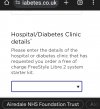retrogamer
Well-Known Member
- Messages
- 101
- Location
- UK
- Type of diabetes
- Type 2
- Treatment type
- Tablets (oral)
- Dislikes
- Most things that's good for me
Google appears to be a huge source of misinformation regarding diabetes. Many pages I read tell a difference story about what "normal" levels should be.
I decided to test myself last night, I've been very good with carb free stuff for several weeks and bg has been around 5.6 - 6.0
I hadn't really tested before and after a meal so I decided to try something with carbs and see how I reacted. I had a baked potato, just with butter and cheese. Bg test immediately before was 5.6 as always, I got impatient and tested after about 1hr 45mins instead of the recommended 2 hours and it was 10.4
I cannot for the life of me find a reliable source of information to tell me if this is good or bad. Some sources say after 2 hours it should be below 8.5 in a non diabetic, others say 9 or even 9.5!
Is there an accurate source of information regarding what bg readings are acceptable and what is way above normal?
P.S. I am not falling off the low carb wagon, I intentionally chose to test myself with a high carb item because I sometimes still make mistakes and occasionally eat something that has more carbs than I realise. (As I'm sure many have at the start)
I decided to test myself last night, I've been very good with carb free stuff for several weeks and bg has been around 5.6 - 6.0
I hadn't really tested before and after a meal so I decided to try something with carbs and see how I reacted. I had a baked potato, just with butter and cheese. Bg test immediately before was 5.6 as always, I got impatient and tested after about 1hr 45mins instead of the recommended 2 hours and it was 10.4
I cannot for the life of me find a reliable source of information to tell me if this is good or bad. Some sources say after 2 hours it should be below 8.5 in a non diabetic, others say 9 or even 9.5!
Is there an accurate source of information regarding what bg readings are acceptable and what is way above normal?
P.S. I am not falling off the low carb wagon, I intentionally chose to test myself with a high carb item because I sometimes still make mistakes and occasionally eat something that has more carbs than I realise. (As I'm sure many have at the start)


